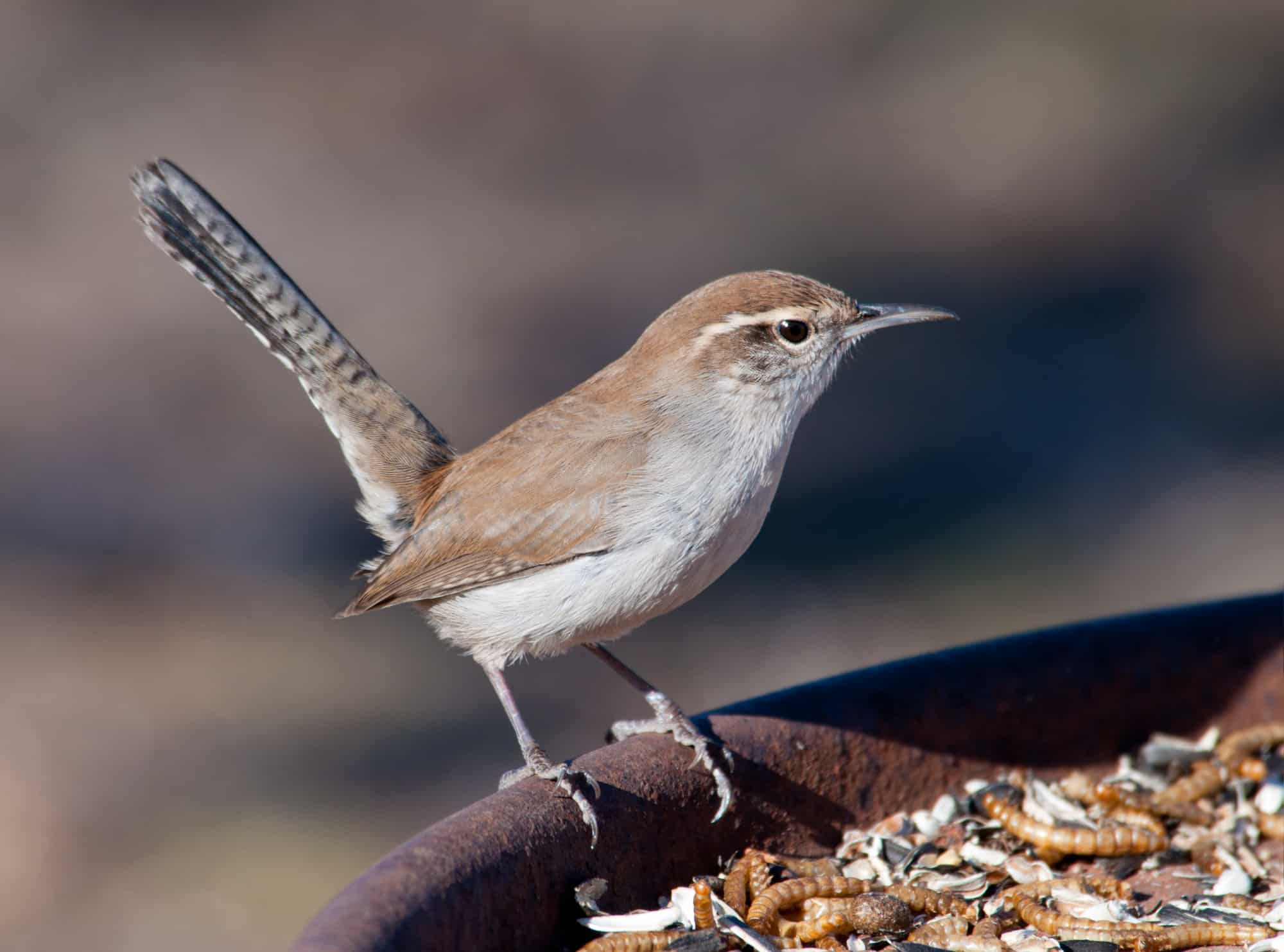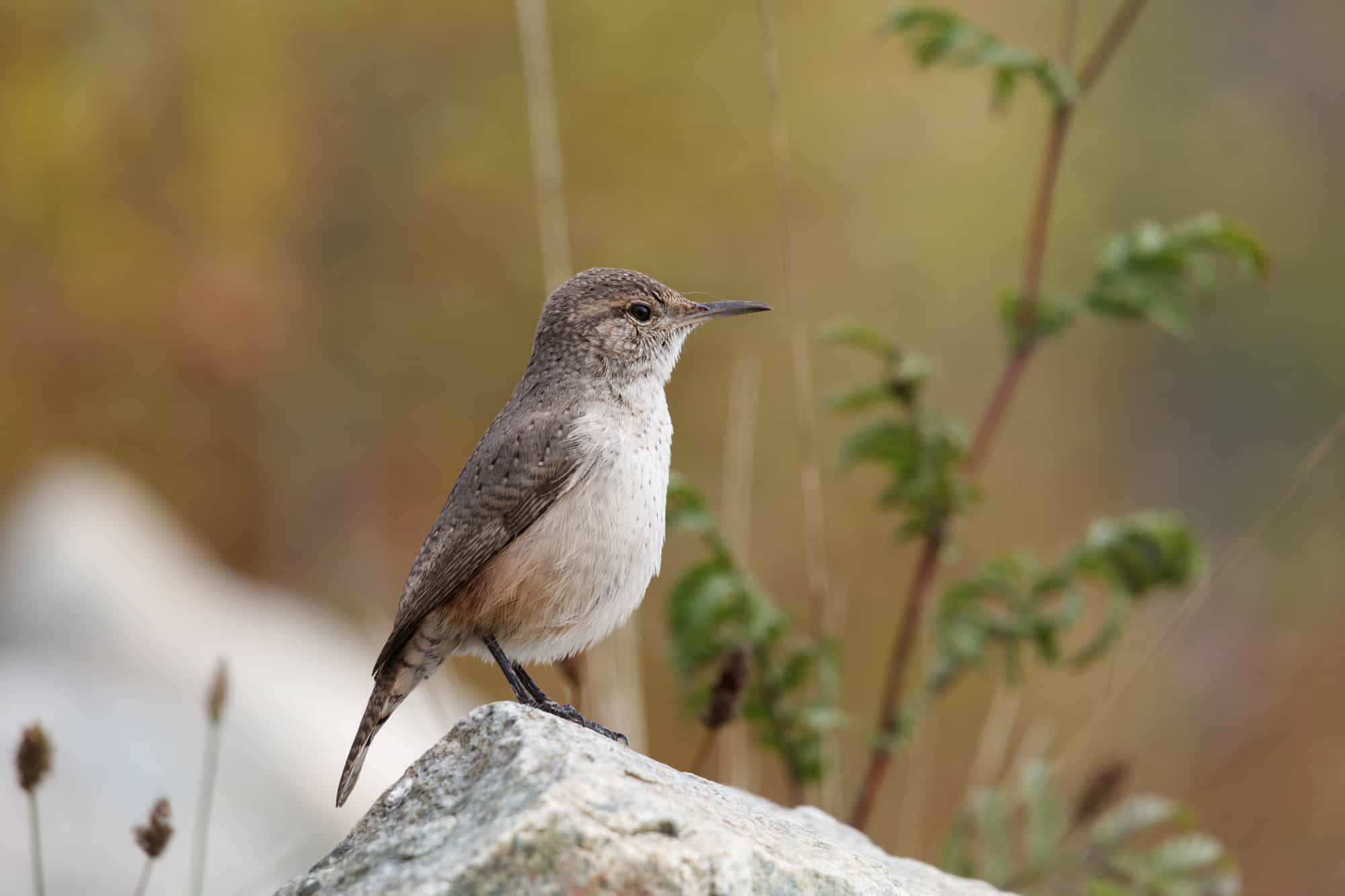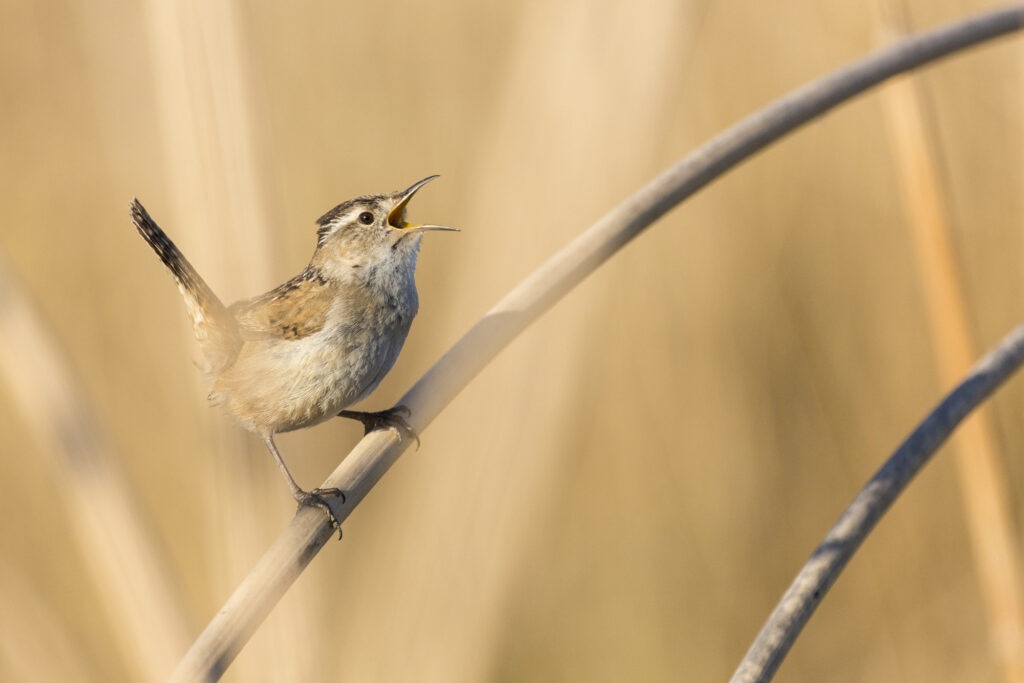Arkansas, The Wonder State, is home to around 400 species of birds, and seven of them are wrens.
Wrens are among the most diminutive of all birds in Arkansas, but what they lack in size, they more than make up for in personality!
Wrens will often scurry about silently in the undergrowth, remaining hidden and elusive before making you jump out of your skin with their heart-stopping song.
Several species of wren can be attracted to your backyard by offering them a suitable nest box, which they’ll also sometimes use as a sheltered place to roost in the winter months.
Let’s take a closer look at Arkansas’s wrens, starting with the most frequently seen species, and finishing with the rarest, most highly prized species.
Wrens in Arkansas, Starting With the Most Common
Carolina Wren

- Scientific Name: Thryothorus ludovicianus
- Length: 4.7-5.5 in (12-14 cm)
- Weight: 0.6-0.8 oz (18-22 g)
- Wingspan: 11.4 in (29 cm)
The enchanting Carolina wren of the eastern states is the most common member of the family in America, and also the most frequently seen in Arkansas. These larger wrens don’t migrate and are reported by more than one in three bird watchers in the state throughout the year.
Carolina wrens are extremely pretty birds with attractive orange-pink flanks and ornate white eyebrows. They also have a very loud song for their size – a series of repeating high-pitched phrases that can almost sound like a car alarm.
You can attract Carolina wrens to your backyard in winter by offering them a platform feeder or tube bird feeder. They enjoy eating suet, hulled sunflower seeds, and other fatty foods.
Carolina wrens mate for life and are opportunistic nesters. They’ll sometimes use an appropriate nest box such as a gourd bird house for nesting, even when placed close to the house. A real treat for a bird-loving household!
Winter Wren

- Scientific Name: Troglodytes hiemalis
- Length: 3.1-4.7 in (8-12 cm)
- Weight: 0.3-0.4 oz (8-12 g)
- Wingspan: 4.7-6.3 in (12-16 cm)
True to their name, you’re only likely to see winter wrens in Arkansas during the colder months. In the spring they migrate north, mainly to Canada and high mountains in the east for nesting.
Along with their western cousin, Pacific wrens, winter wrens are the smallest wren species in North America. Despite that, their stocky shapes make them heavier than larger species like the house wren!
The winter wren has one of my favorite songs of any bird’s songs. Listen out for a long, vigorous, and almost unbroken series of high-pitched trills and warbles.
Despite its booming voice, the winter wren is otherwise a fairly secretive bird. It’s most often seen hurrying through overgrown vegetation and brush piles, especially near water in damp woodlands.
House Wren

- Scientific Name: Troglodytes aedon
- Length: 4.3-5.1 in (11-13 cm)
- Weight: 0.3-0.4 oz (10-12 g)
- Wingspan: 5.9 in (15 cm)
The humble house wren is the only other wren that you have a reasonable chance of seeing in Arkansas. These birds are not exactly common in the state but are seen throughout the year in different regions.
You’ll only see house wrens in winter at the lower altitudes in the south and east of the state. In summer they’re only to be found in the northern Boston mountains.
By far the best time to see house wrens in Arkansas, however, is in the fall migration when they can be seen statewide. They’re checked off by one in every fifteen bird watchers during October.
House wrens are plucky little birds that can sometimes be attracted to birdhouses, so you could try your luck if you live in the north of the state! They’re mainly insectivorous and are not attracted to bird feeders.
Marsh Wren

- Scientific Name: Cistothorus palustris
- Length: 3.9-5.5 in (10-14 cm)
- Weight: 0.3-0.5 oz (9-14 g)
- Wingspan: 5.9 in (15 cm)
All of the remaining wrens on our list for Arkansas are fairly rare in the state. Marsh wrens will occasionally spend the winter in Southern Arkansas but are seldom seen in the breeding season.
Your best chance of seeing these small wrens is to take a good pair of binoculars and search wetland vegetation such as cattails and reeds with standing water underneath.
The difficulty of accessing such habitats and the secretive nature of the marsh could partially account for the lack of sightings. During migration, they’re seen more often in other habitats, especially in the fall.
Marsh wrens are feisty little birds that will sometimes attack other nesting birds in their territories or even destroy the nests of their competitors! Their long buzzy song can last for 20 minutes!
Sedge Wren

- Scientific Name: Cistothorus stellaris
- Length: 3.9-4.7 in (10-12 cm)
- Weight: 0.3oz (7-10 g)
- Wingspan: 4.7-5.5 in (12-14 cm)
Like the marsh wren, the sedge wren enjoys damp environments but prefers less watery ones than its relatives. They don’t require standing water to feel at home and can also be seen in damp grassy meadows.
These tiny birds blend in perfectly with their sedge marsh habitats. Their barred wings make them highly camouflaged, and they often creep through vegetation rather than taking flight.
As with many wrens, then, your best chance of locating a sedge wren is when they’re singing. Their song consists of a series of clipped chips and rather tuneless trills.
Sedge wrens are primarily winter birds in Southern Arkansas, although there is one rare breeding outpost in the mountainous northwest of the state, too.
Bewick’s Wren

- Scientific Name: Thryomanes bewickii
- Length: 5.1 in (13 cm)
- Weight: 0.3-0.4 oz (8-12 g)
- Wingspan: 7 in (17.8cm)
Because the Wonder State lies at the eastern edge of this Bewick’s wren’s westerly range, it is neither a common bird in summer nor in winter in Arkansas.
A declining population of Bewick’s wren, however, still exists in the mountainous northwest of Arkansas in the summer months, and in the southern lowlands during winter.
Although they could be confused with a house wren or a Carolina wren from a distance there are some notable field marks. Bewick’s wren has a whiter underside than the other species and a heavily barred tail, with white tips in the corners.
Bewick’s wren’s song varies a lot according to the locality, but in the east, they tend to have a complex musical trill, somewhat resembling a song sparrow.
Rock Wren

- Scientific Name: Salpinctes obsoletus
- Length: 4.9-5.9 in (12.5-15 cm)
- Weight: 0.5-0.6 oz (15-18 g)
- Wingspan: 8.7-9.4 in (22-24 cm)
Rock wrens are one of the rarer wrens in the United States and are only normally seen in the western half of the country. In Arkansas, they can be treated as vagrants.
True to their name these energetic birds tend to seek out arid, rocky habitats. They use their long bills to search cracks and crevices for insects and other invertebrates.
The rock wren is larger than most wrens, but still smaller than the Carolina wren. It’s also paler than other wrens, with an attractive light, chalky underside.
Rock wrens have the lovely habit of bouncing up and down on a rock as they sing their jumbled, slightly mechanical song.
Conclusion
There are plenty of opportunities to enjoy wrens in Arkansas, although only three species are frequently seen here.
If you’re in the right place at the right time, you may see some of the others, too, and their rarity only makes the encounter more exciting.
Besides wrens, there are all kinds of colorful and characterful birds in Arkansas. From more than 400 bird species, we’ve whittled down the lists of 26 Must-see birds in The Wonder State and 22 Small Birds in Arkansas.

